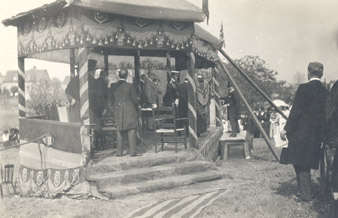It was the first building on what is today Dal’s Studley campus. One hundred years later, the Chemistry Building is still standing as a centre for teaching, research and study.
Last Friday afternoon, faculty, staff, students and alumni gathered together to celebrate the building’s 100th anniversary. While the official anniversary of the start of construction was on August 15, event coordinators decided to incorporate this special milestone into Homecoming weekend.
The celebration was led by Department Chair Josef Zwanziger, who took alumni on a guided tour of the building, followed by a presentation on the building’s long-standing history.
A home for Dal sciences
Originally deemed the “Science Building” because it housed the department of chemistry, physics and geology, it was envisioned as the academic core of the campus. The project was realized by architect Frank Darling of Toronto, who surveyed the lot in 1911 and created a general campus plan. Darling chose a local architect, Andrew Randall Cobb, to design the buildings. Together, they decided on an 18th century Georgian style of architecture in keeping with other attractive buildings in Halifax such as Province House and Government House. The Georgian style was adaptable and would lend an inviting, “domestic” appearance to the campus. In his annual report of 1911/12, Dalhousie President Arthur Stanley MacKenzie praised the new building as "by far the largest and finest building for pure science east of McGill."
 The Chemistry Building's cornerstone was laid on August 15, 1912 by the Governor General, the Duke of Connaught, in a ceremony attended by the High Commissioner for Australia, the premiers of Quebec and Nova Scotia and the Governor of Newfoundland. (See photo on left, via Dalhousie Archives and Special Collections.) Construction was funded by a Carnegie Corporation grant of $50,000, with Dalhousie required to raise an additional $40,000.
The Chemistry Building's cornerstone was laid on August 15, 1912 by the Governor General, the Duke of Connaught, in a ceremony attended by the High Commissioner for Australia, the premiers of Quebec and Nova Scotia and the Governor of Newfoundland. (See photo on left, via Dalhousie Archives and Special Collections.) Construction was funded by a Carnegie Corporation grant of $50,000, with Dalhousie required to raise an additional $40,000.
With Cobb’s efforts, in conjunction with the input from science professors Eben Mackay and Howard Bronson, the final plans were completed in January of 1913. The building was finished by summer 1915, and Dal’s science programs moved from their home in Forrest Building.
Expansion and evolution
The building was constructed of hard ironstone from Purcell's Cove, along with Portland cement. Originally, it was designed as two separate buildings in one, so that the hazardous fumes of the Chemistry department would be isolated. There was also space allotted to the Engineering and Geology departments, part of the building until 1945. Despite the building's integrity, on December 6, 1917 it was severely damaged in the Halifax Explosion. Repairs to doors, windows and the roof were extensive and cost almost $10,000, a sum readily paid by the Carnegie Corporation.
 By 1960 after many years of construction and expansion — some things never change at Dal — it came to pass that Chemistry would occupy the entire building (the photo on the right is from 1937). In 1965, the building was joined to the adjacent Macdonald Memorial Library (now the Macdonald Building). The extension created 40,000 square feet of new floor space and added additional departmental offices, the university bookstore and a lecture hall. A $9.8 million extension and renovation in 1991 updated the building and facilities and added almost 23,000 square feet on the north side of the building, including new undergraduate laboratories.
By 1960 after many years of construction and expansion — some things never change at Dal — it came to pass that Chemistry would occupy the entire building (the photo on the right is from 1937). In 1965, the building was joined to the adjacent Macdonald Memorial Library (now the Macdonald Building). The extension created 40,000 square feet of new floor space and added additional departmental offices, the university bookstore and a lecture hall. A $9.8 million extension and renovation in 1991 updated the building and facilities and added almost 23,000 square feet on the north side of the building, including new undergraduate laboratories.
Today, the Department of Chemistry has 26 professors, four emeritus professors, 13 adjunct professors, seven instructors, and 14 technical/administrative staff. It welcomes visiting scientists, postdocs and research assistants alongside its 70 graduate students, more than 40 honours students and 3,000-plus students who take undergraduate chemistry courses each year. Its facilities include the computer-aided learning laboratory, laser photolysis laboratories, the Nuclear Magnetic Resonance Research Resource, the Trace Analysis Research Centre, the Mass Spectrometry Laboratory and many other specialized facilities. Faculty and students carry out research in all areas of chemistry: analytical, bio-organic, computational, environmental, inorganic, materials, organic, physical and theoretical.
A proud celebration
After the history tour, a ceremony was held outside the building allowing guests to reflect on this long legacy. Attendees included Leonard Preyra, minister of communities, culture and heritage, and Marilyn More, minister of labour and advanced education, both of whom offered their congrats on behalf of the Government of Nova Scotia.
President Tom Traves, who unveiled the commemorative plaque celebrating the century mark, was enthusiastic as he recounted the department’s endeavors, from housing one of the first Chemistry professors in Canada, George Lawson, to its national and international reputation for being a world-class research engine.
But the message Dr. Traves wanted his guests to remember that day was not the building, or the research labs, but rather, “our outstanding faculty, our curious and highly motivated students, and our technical and support staff. It is the people inside that make this building so great.”

